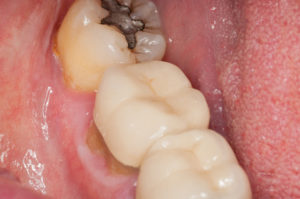Glacier Centre for Dentistry
Dr. Kurt Lindemann, DDS /
Kalispell - Gum Disease Treatment
 Are you worried you’re suffering from some form of gum disease? Maybe you already know you have a form of periodontal (gum) disease but don’t know how to start caring for your gums. Periodontal disease affects many adults in the U.S. as millions of people will develop a form of gum disease in their lifetime. The good news is that Glacier Centre for Dentistry has been helping people in the Kalispell area combat gum disease for years. We make every effort to educate our patients on prevention while keeping treatments as quick and painless as possible. Proper care of your teeth and gums moving forward will determine whether your periodontal disease is stopped, slowed or gets worse in the future. So don’t let fear hold you back from talking to your dentist about taking care of your gums!
Are you worried you’re suffering from some form of gum disease? Maybe you already know you have a form of periodontal (gum) disease but don’t know how to start caring for your gums. Periodontal disease affects many adults in the U.S. as millions of people will develop a form of gum disease in their lifetime. The good news is that Glacier Centre for Dentistry has been helping people in the Kalispell area combat gum disease for years. We make every effort to educate our patients on prevention while keeping treatments as quick and painless as possible. Proper care of your teeth and gums moving forward will determine whether your periodontal disease is stopped, slowed or gets worse in the future. So don’t let fear hold you back from talking to your dentist about taking care of your gums!
Causes of Gum Disease
The human mouth is full of different forms of bacteria. Gum disease is typically caused by improper oral hygiene which allows the bacteria to remain in “pockets” on the teeth, at the gum line or even below the gum line. Bacteria along with mucus and other particles form a sticky substance referred to as “plaque” which tends to stick in these pockets. This bacteria can have major adverse effects on overall oral health and increase the risk of developing gingivitis and periodontitis. Regular teeth brushing and flossing help rid the mouth of plaque and bacteria, however, the plaque that is not removed can harden and form “tartar” that brushing cannot remove. This is when regular trips to the dentist are needed to remove the tartar.
Common Risk Factors Include:
- Smoking & tobacco use
- Heavy use of alcohol
- Diabetes
- Taking certain medications
- Genetic susceptibility
- Other illnesses (due to weakened immune system)
Typical Treatment Options
There are a few ways to treat gum disease and they typically depend on the severity of the disease and recommendations from your dentist or periodontist. If you are suffering from gum disease, then the best course of action moving forward is to control the bacteria both above and blow the gum lines.
Non-Surgical Treatment Methods
Professional dental cleanings - During your routine checkup or visit, your dentist or hygienist will remove plaque and tarter on the surface of the tooth as well as above and below the gum line of the teeth. If it is very early in the diagnosis, your dentist may recommend cleanings more than twice a year.
Scaling & root planing - A deep cleaning may be deemed necessary by your dentist both above and below the gum line. A local anesthetic is administered and plaque and tarter is scraped away from the teeth (scaling) and the teeth are smoothed over to prevent bacterial build-up (planing). This provides a nice smooth surface for the gums to reattach to.
Surgical Treatment Methods
Sometimes when the disease has progressed further, surgical treatments are necessary for repair. The recommended course of action may vary and should be discussed with your dentist or periodontist, but can include:
- Flap or pocket reduction surgery
- Soft tissue grafts
- Guided tissue regeneration
- Bone augmentation (in very progressed cases)
- Bone grafting (in very progressed cases)

